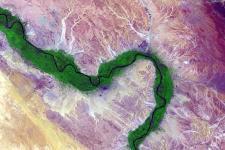An effective use of space-based information in all phases of the disaster management cycle requires access to data and tools as well as knowledge of relevant methods. When data and data products are accessible and the capacity to use or create resources is built, countries as well as national or international organizations can create space-based products tailored to their individual needs and conditions.
In this section, we provide entry points to a wide range of resources related to the use of space-based information for disaster risk management and emergency response. Each database referred to below allows filtering resources according to parameters such as hazard time and satellites or sensors used to obtain the data.
Institutions
UN-SPIDER is mandated to act as a bridge between the space and disaster management communities. To facilitate the discovery of relevant institutions, the programme compiles relevant disaster management institutions, space agencies and international institutions. The organizations are presented briefly and links are provided to access their respective websites.
Data Application of the Month
UN-SPIDER regularly writes up information about how specific data can support addressing a particular hazard. These pages also include links to access the related data and products as well as information about tools that might be useful to process the information.
Data Sources
Access to data is key for making use of the benefits of space-based information in disaster management. For this reason, UN-SPIDER regularly adds links to a large variety of satellite imagery sources, elevation models, land use and land cover maps as well as near real-time data products for different hazard types. Users can search the database by data type, hazard or disaster management cycle phase, as well as other relevant factors including costs, temporal or spatial coverage, sensor or file types. The results of each search are connected to UN-SPIDER's database of GIS and remote sensing software suggesting links to adequate software for each data type.
GIS and Remote Sensing Software
To process space-based data, users require adequate software that allows them to create relevant information products. UN-SPIDER hosts links and descriptions of GIS and remote sensing software including both free and commercial applications. Users can search this database by different criteria, including software type, data format, scope or file types. In order to use or download the software, links to the specific provider are shown. The different software profiles also point to existing online tutorials to support users developing their skills in using these applications.
External Online Training Opportunities
In addition to linking to external in person training opportunities, UN-SPIDER also compiles a list of available online training courses such as MOOCs and webinars. These can be filtered according to the hazard type and software the training includes. Online training opportunities range from hands-on tutorials that explain how to develop a particular information product to series of videos that provide background information about using satellite data in disaster management. These courses are instructor-led live online courses, which take place at a specific time and require attendance in the live session.
Online Learning Resources
Similar to the External Online Training Opportunities, UN-SPIDER compiles a list of available online learning resources. These can be ongoing (on-demand) online courses, such as MOOCs and webinars. The courses usually are self-paced and can be taken at the user's desired time. Some of these courses may be former instructor-led live courses, which are made available after the respective course was completed.

